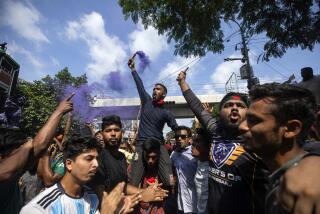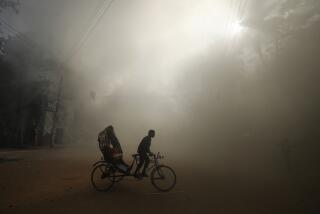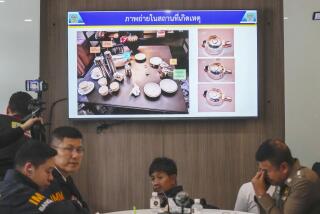Thailand: Troops storm protest zone
Reporting from Bangkok, Thailand, and New Delhi â After days of amassing troops, warning civilians to flee and skirmishing with anti-government protesters, Thailandâs army broke through barricades of tires and bamboo staves at daybreak Wednesday in a bid to end by force a two-month occupation of Bangkokâs glitzy downtown property.
Amid clouds of tear gas, armored personnel carriers moved toward the barriers that demonstrators erected in recent weeks to protect their mile-square protest enclave in the capitalâs prime shopping district. Nearby, other troops fired water cannons and combed through the tire and bamboo mounds theyâd overrun, searching for explosives. News reports said four people were shot dead, including an Italian news photographer, and about 50 were wounded.
It was not immediately clear whether this was a final push or an interim step designed to flush out women and children from the protest zone occupied by the â Red Shirts,â as the demonstrators call themselves. Even as armored vehicles pushed down the flimsy barriers, most troops initially remained outside the protest zone.
The estimated 3,000 to 5,000 protesters, many drawn from rural, poor and working-class groups, have demanded the immediate resignation of Prime Minister Abhisit Vejjajiva, the dissolution of parliament and new elections to replace a government that they believe is illegitimate.
âWhy would I go home?â said Sakorn Rangkalin, 54, a homemaker from Kalasin province, shortly before the assault started. âThe Cabinet is still not dissolved.â
Bangkok Gov. Sukhumbhand Paribatra told a Thai TV station on Wednesday morning that four trucks were prepared to evacuate women and children from Pathumwanaram Temple, inside the protest zone, where they had taken refuge.
Evacuation was complicated, he said, by reports that bombs had been placed at the templeâs entrance. He warned Bangkok residents to stay in their homes in case the unrest spread to other areas.
In preparation for Wednesdayâs military push, the government had announced a weeklong holiday in Bangkok lasting through Friday and cut off power, water, food and cellphone coverage to the protest area, although the cordon wasnât airtight. Street fighting over the last week has killed at least 39 people, mostly civilians, and wounded hundreds. Television footage showed soldiers crouched in the shadow of armored vehicles beneath overpasses as plumes of dark black smoke from ignited tires rose nearby and ambulances raced into the area.
The operation will continue throughout the day âto make sure that security officers can provide security and safety to the public at large,â government spokesman Panitan Wattanayagorn said on national television, and is designed âto secure the parameter in several locations in Bangkok.â
He added that Red Shirt leaders appeared to have slipped past the military.
Securing such a large area represents a significant challenge for the army and police, security experts said, and ideally they would want to control as much of the area as possible before darkness, when they would be more vulnerable to snipers and ambush.
âThe longer it lasts, the more resistance theyâll face,â said David Tuck, Bangkok-based research director with Spectrum OSO Asia, a risk analysis firm. âIf it gets dark, things could get nasty.â
Starting the assault in the morning, rather than attempting to surprise protesters while sleeping, allows the army to better see whatâs going on, analysts said, amid hope there would be less confusion and fewer panicked protesters caught in crossfire. Red Shirt supporters expressed concern Wednesday about the risk of such casualties. âThis is a very violent reaction on people protesting in a nonviolent approach,â said Suda Rangkupan, a linguistics professor at Chulakorn University who has joined the protests and given supportive speeches. âItâs very cruel, very terrible.â
But she and others vowed to fight on. âEven though we lose to the guns, the minds and hearts for democracy keep going on,â Rangkupan said.
Peter Warr, executive director of the Australian National Universityâs National Thai Studies Center, said authorities ultimately decided they had had enough.
âThis is very costly and really disrupts the city, and thereâs a limit to how long the government can allow it,â he said. âThe problem with negotiating is that you donât know who youâre negotiating with. Thereâs no Red Shirt leadership structure.â
Analysts said the armyâs apparent go-slow approach could reduce casualties, but the army also risks losing the initiative if anti-government protesters regroup outside the protest zone, giving rise to a multifront conflict.
One strategy might see the army try to push most of the protesters into the central Ratprasong area, where the main protest stage is located, at which point they could be dispersed.
Although popular support for the Red Shirts remains high in many rural areas, many Bangkok residents who initially empathized with them have grown weary of the chaos, transportation disruptions, shuttered shops and canceled business meetings.
âFrom my heart, I am sympathetic to the Red side, but I want this to stop, itâs created many problems with businesses all over,â said Kun Jamsai, a travel agent in Bangkokâs Banglamphu district. âYou see the news every day, and you see gunshots, bombs. Itâs too much for Bangkok.â
As people waited to see how hard and fast the military would move into the protest area, most could only hope that casualties would be minimized.
âI donât want violence, I just wish both sides could talk to make something better for our country,â Kun said. âNow, I donât know how it will end.â
Tran reported from Bangkok, Thailand, and Magnier from New Delhi.
More to Read
Sign up for Essential California
The most important California stories and recommendations in your inbox every morning.
You may occasionally receive promotional content from the Los Angeles Times.










